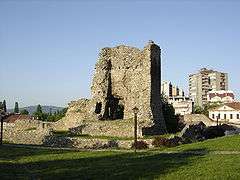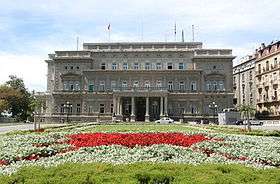Kruševac Fortress
| Kruševac Fortress City of Prince Lazar | |
|---|---|
 Kruševac Fortress Keep | |
| General information | |
| Architectural style | Fortification, mixed |
| Town or city | Kruševac |
| Country |
|
| Completed | 1381 |
Kruševac Fortress or City of Prince Lazar (Serbian: Крушевачки град, Kruševački grad) was a medieval fortified town in Kruševac, Serbia, former capital of Prince Lazar. Within the city there is the court church Lazarica. Today, all that remains of the town is very small ruins.[1]
History
Fort in Kruševac was first mentioned in 1381, so it was probably built by Prince Lazar or he significantly expanded and strengthened an earlier fortress that was there. It is then located princes capital, from which he ruled his country as attested signature and record in a charter issued in 1387 which states In the famous city of my dominion Kruševac (у славноме граду господства ми Крушевцу)
Lazar's son and successor Stefan managed Despotate from Kruševac until 1405, when the capital was moved to Belgrade, which in 1403 began to renew and fortified. However Kruševac didn't lost its importance, because the despot in it met with Sultan Mehmed I in 1413.
Struggle over control of the city have ceased during the entire first half of 15th century, and it was given to the Turks briefly in 1413, and in 1427 (Despot Stefan gave it before the end of his life). In 1437 Hungarians occupied the fort. After signing Agreement on the restoration of Despotate Đurađ Branković Smederevac regain Fortress in 1444, but Turks definitely win it in 1454, when fort was renamed Aladža Hisar, Turkish for Colorful City, because of the diversity of materials from which the fortress was built.
Archaeological site
The best preserved part of the former Prince Lazars capital of the palace church of St. Stephen, Lazarica. In addition it is very little left of the Hard town of Kruševac, as it is called by Constantine of Kostenets. Today, the survival remains are Donjon Tower, through which you entered the city and part of Eastern wall. Inside the walls of the towers today are still a hallway with staircase, through which arrived on the higher levels and exited on the city walls. One of the curiosities of this particular tower was platered with pebbles, which is rare and probably one of the reasons for the Turks to give the name of the whole fortress Colorful City. The area of the former fortress was turned into a park where there is now a museum. The park is almost entirely neglected, except around the church. Walls and the remains of other buildings are very poorly preserved, unmarked and in no way are protected from vandals. Part of the walls in the last century was torn down to build houses whose construction probably used stone from the fortress.
But, later, Kruševac Fortress was declared Monument of Culture of Exceptional Importance in 1979, and it is now protected by Republic of Serbia.[1]
See also
References
Sources
- Monuments of Culture in Serbia: ЦРКВА СВ.СТЕФАНА ЛАЗАРИЦА СА КРУШЕВАЧКИМ ГРАДОМ (SANU) (Serbian) (English)
- Републички завод за заштиту споменика културе – Београд. "Црква Св. Стефана Лазарица са Крушевачким градом". БАЗА НЕПОКРЕТНИХ КУЛТУРНИХ ДОБАРА.
External links
- Association of fortresses and remnants of fortified towns in Serbia, Kruševac
- Church of St. Stefan Lazarica with Kruševac Fortress SANU web-site, at www.spomenicikulture.mi.sanu.ac.rs (Serbian)
Coordinates: 43°35′04″N 21°19′19″E / 43.58444°N 21.32194°E


